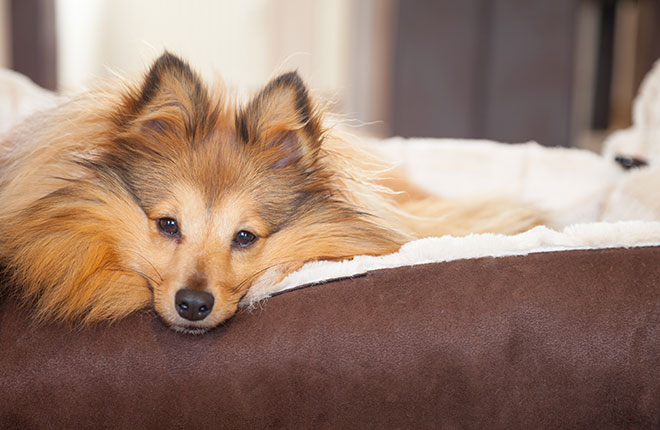If your dog seems to be moving slower and you’re blaming it on old age, they might be suffering from osteoarthritis (OA). If so, things like slippery floors can cause instability and stairs can be a challenge — and painful — making your home a difficult place for your dog to navigate.
While managing your dog’s pain and quality of life includes keeping them active and able, you can make small changes in your home to make it easier for them to get around and to help them be more comfortable.
If your dog is in pain, it’s important to talk to your veterinarian about medications that can help. Along with these medications and supplements your veterinarian may prescribe, here are some steps that you can take around your home to make it easier for your dog to thrive in their environment.
Add Slip-Resistant Surfaces
Since many dogs with osteoarthritis have difficulty stabilizing themselves on slippery surfaces like vinyl, tile, or hardwood, adding slip-resistant surfaces to your home helps your dog feel more secure when walking. Some common slip-resistant surfaces to add to your home are carpet treads on wood stairs, area rugs or runners, or even yoga mats.
Rugs. Older dogs suffering from muscle weakness and decreased coordination may drag their feet and get tripped up on rugs that curl up. To reduce this risk, you can put adhesive strips under the corners of a rug to make them lie flat and use a non-slip pad underneath to help them stay in place.
Grippy socks. These can give your dog the traction they need not to slip on the floors in your home. If your dog will wear them, this could be a great addition to having rugs on hard surfaces, and to give traction on those areas that don’t have rugs or carpet. It also makes getting up from a lying position easier.
Regular nail trims help keep their nails short and minimize the pressure on your dog’s feet. If you don’t stay on top of nail trims, your dog’s nails can grow long enough to make walking hurt or cause a limp. And don’t forget to trim dewclaws, which can grow into their skin and cause infection.
Provide Them with Supportive Bedding
As your dog ages, the type of bed they use starts to matter even more. A supportive orthopedic bed or one made from memory foam helps to support and cushion their joints while they rest. Also, your dog’s discomfort can increase in cold weather, so providing them a warm, comfortable sleeping area can help lessen their pain.
Elevate Their Food and Water Bowls
Many dogs with osteoarthritis have difficulty bending their neck to get to their food or water bowl. Elevated bowls can help ease the strain on their neck and back, making it easier for them to stay hydrated and get the nutrients they need to stay healthy. If your dog is a breed that is at increased risk for gastric dilatation volvulus (GDV) or bloat, speak with your veterinarian first before elevating your dog’s food and water bowls, as doing so may increase a dog’s risk for developing this life-threatening condition[1].
Offer Them Mobility Assistance
Ramp. If your dog has trouble getting in and out of cars or your bed, a ramp may be a great option to help them continue with the activities they love without the pain. Just make sure the ramp isn’t too steep or too slippery for your dog.
Assistance harness. Harnesses with a handle can help you take some weight off your dog’s joints for bathroom trips or getting from one spot in the house to the other. This is a great option for dogs with severe osteoarthritis. In a bind and don’t have a specific harness? Roll up a beach towel and sling it under their belly, just in front of their back legs, to provide some temporary mobility support for them.
ZPC-00268R2
IMPORTANT SAFETY INFORMATION: Librela is for use in dogs only. Women who are pregnant, trying to conceive or breastfeeding should take extreme care to avoid self-injection. Hypersensitivity reactions, including anaphylaxis, could potentially occur with self-injection. Librela should not be used in breeding, pregnant, or lactating dogs. Librela should not be administered to dogs with known hypersensitivity to bedinvetmab. Adverse events reported post-approval include ataxia (lack of balance/coordination), anorexia (loss of appetite), lethargy (tiredness), emesis (vomiting), and polydipsia (increased drinking). The most common adverse events reported in a clinical study were urinary tract infections, bacterial skin infections and dermatitis (skin irritation/inflammation). See full Prescribing Information.
See the Client Information Sheet for more information about Librela.
- Glickman LT, et al. Non-dietary risk factors for gastric dilation volvulus in large and giant breed dogs. J Am Vet Med Assoc. 2000;217:1492–1499.




